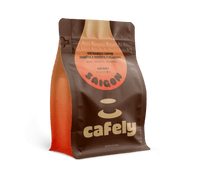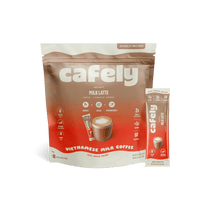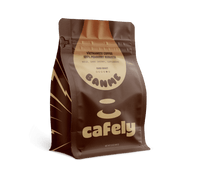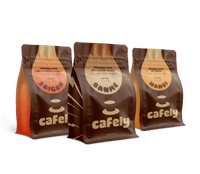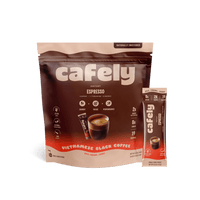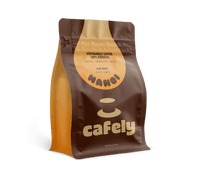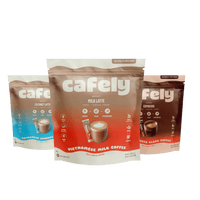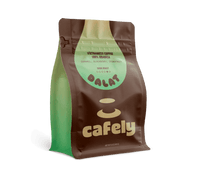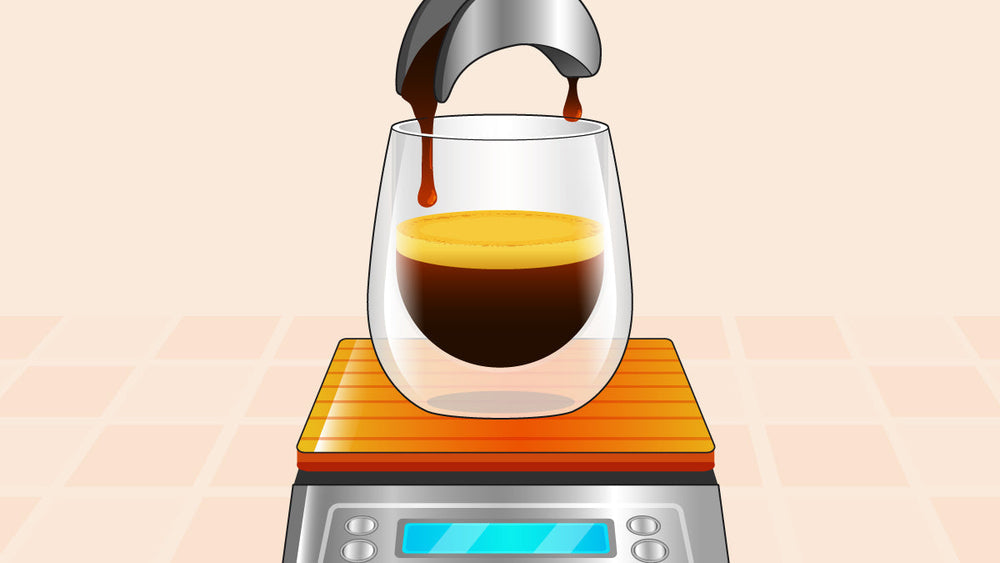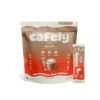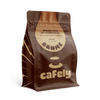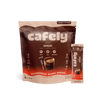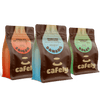As strong as espresso is, it’s also easy to underestimate. It doesn’t feel like much when you look in your cup and there’s only an ounce or two. So when you're on your third or fourth shot, it might not seem like you're overdoing it.
But, how many shots of espresso are too much?
Caffeine consumption isn’t the same for everyone, but there are solid guidelines that can help you know your limit before side effects kick in.
In this article, you’ll learn how many shots are generally safe, how much caffeine is in an espresso shot, and why your own body might need more or less.
How Many Shots of Espresso Is Too Much? General Guidelines
Most healthy adults can safely consume up to 400 milligrams (mg) of caffeine per day. That’s the limit recommended by the U.S. Food and Drug Administration (FDA), and it’s the same number used by most health experts.
A single shot of espresso typically contains between 60 and 100 mg ofcaffeine, depending on the type of beans for espresso. That means 4 to 5 shots of espresso puts you right near the upper safe limit, around 240 to 500 mg total.
If your shots are on the stronger side (closer to 100 mg each), hitting that limit only takes about four. If they’re milder, five shots might be okay. Either way, that’s the maximum, not a target. It’s the ceiling where you should stop, not the level you need to hit.
And keep in mind that number assumes you’re not getting caffeine from anywhere else. If you’ve also had cold brew, soda, energy drinks, or even a bar of chocolate, you’re adding more caffeine on top of your espresso. That can easily push you over the safe range without realizing it.
Your Limit Might Be Lower
The 400 mg guideline works for most people, but not everyone.
These factors can lower your personal caffeine limit:
- Body weight: If you’re on the lighter side, smaller doses will hit harder.
- Caffeine sensitivity: Some people feel jittery after just one shot, especially if they don’t drink coffee often.
- Medical conditions: If you have anxiety, heart arrhythmias, or high blood pressure, your safe range may be much lower.
- Medications: Certain drugs interact with caffeine, making side effects stronger or riskier.
- Age and lifestyle: Sleep patterns, stress levels, and alcohol use can all change how your body handles caffeine.
What Happens If You Take Too Much Caffeine?

Regularly going above 400 mg a day, especially from espresso, which hits fast, can cause a range of side effects.
You might notice restlessness, trouble sleeping, irritability, or a racing heart. Some people even experience nausea or dizziness. These are all signs that your system is overstimulated and needs a break.
Long-term, consistently high caffeine intake may affect blood pressure, heart rhythm, or digestion. If you’re noticing daily side effects, it’s worth taking a look at how much espresso you’re really drinking, and when.
Understanding Caffeine Content in Espresso
While espresso is known for its strong flavor and quick hit of caffeine, the actual amount of caffeine in each shot can vary quite a bit.
If you're trying to track how much you're consuming, you need to understand what affects those numbers and how espresso caffeine compares to other drinks you might reach for during the day.
How Much Caffeine Is in a Single Shot of Espresso?
A standard shot of espresso is about 1 ounce (30 mL). On average, it contains between 60 mg and 100 mg of caffeine. That’s a pretty wide range, and it depends on a few key variables.
If you assume 75 mg per shot as a middle-ground estimate, four shots would put you at around 300 mg of caffeine, well within the general 400 mg daily limit for most healthy adults.
But if your espresso is on the stronger side, closer to 100 mg per shot, then just four shots could push you to 400 mg. That’s why understanding the factors that affect caffeine levels is so important.
What Affects the Caffeine Content in a Shot?
Several things can impact how much caffeine ends up in your cup, even if the shot looks the same every time.
1. Bean Type: Arabica vs. Robusta
Arabica beans are the most common in specialty coffee shops and contain less caffeine, about 1.2% by weight.
Robusta beans, used more in traditional or budget blends, can contain up to 2.2% caffeine, nearly double the amount.
If your espresso is made with robusta beans or a blend of both, you’re likely getting a stronger caffeine dose.
2. Roast Level
Contrary to popular belief, lighter roasts retain more caffeine than darker roasts by volume.
But since espresso is typically made from dark roasts and is measured by weight, this difference is usually small.
Still, if your shop uses a lighter roast for espresso, the caffeine may be slightly higher.
3. Grind Size & Extraction Time
Finer grinds and longer extraction times allow more caffeine to be pulled from the beans.
Espresso machines apply pressure to extract flavor quickly, usually within 25 to 30 seconds. But if your shot runs longer or uses more coffee grounds, the caffeine content can rise.
4. Cup Size
Some baristas use more than the standard 7 to 9 grams of ground coffee per shot. A “ristretto” (short shot) may contain slightly less caffeine, while a “lungo” (long shot) or heavily packed basket will extract more.
What About a Double Shot?

A double shot, also called a doppio, is the standard in most coffee shops today. It’s usually around 2 ounces and contains 120 mg to 200 mg of caffeine. If you order a latte or flat white, you’re most likely getting a double by default.
That means even one standard drink could put you halfway or more toward your daily caffeine max. If you have two doubles in a day, you’re easily pushing past 300 mg.
Espresso vs. Other Caffeinated Drinks
Espresso is more concentrated than other forms of coffee, but that doesn’t always mean it has more total caffeine.
Here’s how it compares:
- 1 shot espresso (1 oz): 60–100 mg
- Drip coffee (8 oz): 80–140 mg
- Cold brew (12 oz): 150–250 mg
- Energy drink (8 oz): 70–200 mg, depending on the brand
- Green tea (8 oz): 30–50 mg
So while espresso has the most caffeine per ounce, you’re usually drinking less of it. A large cold brew or drip coffee could easily contain more caffeine than two espresso shots combined.
Factors Influencing Your Personal Espresso Limit
Even if two people drink the exact same espresso, their bodies may react very differently. Your personal caffeine limit depends on a range of factors, from your genetics to your body weight, and even what medications you’re taking.
Let’s break down what affects how much espresso you can safely handle.
1. Genetics & Caffeine Metabolism
Caffeine is broken down in the liver by an enzyme called CYP1A2. Some people have a gene variant that makes them fast metabolizers, meaning they break down caffeine quickly and feel fewer side effects.
Others are slow metabolizers, and caffeine stays in their system longer — often causing stronger or longer-lasting symptoms like anxiety, restlessness, or sleep trouble.
Most people fall somewhere in the middle. But if caffeine tends to hit you hard, you could be a slower metabolizer.
You can’t control your genes, but you can adjust your habits. If one shot keeps you buzzing for hours, your personal limit may be far below the recommended 400 mg per day.
2. Body Weight & Composition
In general, lower body weight means stronger effects from a given caffeine dose. If you weigh less than average, you may need to cut back even if your overall health is good.
Also, leaner individuals may feel the stimulating effects of caffeine more than those with higher body fat, since caffeine is water-soluble and distributes differently depending on body composition.
3. Caffeine Tolerance & Habitual Use
If you drink coffee daily, your body builds tolerance. That means you may need more caffeine to feel the same effects, but that doesn’t mean it’s safer to take in more.
Your brain adapts to caffeine, but your heart, stomach, and nervous system don’t always follow.
So while you might not feel jittery after four shots, the caffeine still affects your system in other ways, like heart rate, digestion, or sleep quality.
4. Health Conditions & Medications
Some health conditions make you more sensitive to caffeine. These include:
- Heart arrhythmias (irregular heartbeat)
- High blood pressure
- Generalized anxiety disorder
- GERD or acid reflux
- Insomnia or sleep apnea
Certain medications also interact with caffeine. These include:
- Stimulants (like Adderall or Ritalin)
- Some antibiotics (e.g., ciprofloxacin)
- Asthma medications (like theophylline)
- Thyroid medications
These interactions can either slow down caffeine metabolism, making it stay in your system longer, or increase its stimulating effects.
If you take any prescription meds, ask your doctor or pharmacist if caffeine is safe to combine.
5. Pregnancy & Breastfeeding
During pregnancy, the body metabolizes caffeine much more slowly. That’s why most experts recommend that pregnant women limit caffeine intake to under 200 mg per day — roughly two espresso shots max.
Caffeine can also pass into breast milk in small amounts. While moderate intake is usually considered safe, newborns metabolize caffeine slowly, so it can still affect their sleep or behavior. If you’re breastfeeding, spacing out your espresso or reducing intake can help avoid problems.
Signs & Symptoms of Too Much Espresso (Caffeine Overdose)
Espresso might feel like a quick fix for tired mornings or long workdays, but too much can leave you feeling worse than before.
Because it’s so concentrated, it’s easy to underestimate how much caffeine you’ve had, especially if you’re drinking multiple shots without spacing them out.
Common Signs You've Had Too Much
Most people start to notice symptoms once they go past their caffeine limit, even if they’re still under the 400 mg guideline.
These signs are your body’s way of telling you to slow down:
- Jitters or shakiness
- Anxiety or nervousness
- Restlessness or an inability to sit still
- Trouble sleeping or insomnia
- Increased heart rate or palpitations
- Stomach pain, acid reflux, or nausea
- Headaches
- Dizziness or feeling lightheaded
Even one or two of these symptoms can affect your day. You might feel too anxious to focus or too uncomfortable to relax. Some people also get dehydrated, especially if they haven't eaten or drunk enough water along with their espresso.
Severe Symptoms: When Caffeine Becomes Dangerous

In more extreme cases, too much caffeine can lead to a condition called caffeinism, a full-blown reaction to excessive stimulant overload.
While it’s rare, it can happen if someone consumes large amounts of caffeine in a short time, especially from concentrated sources like espresso, energy drinks, or caffeine pills.
Symptoms of a caffeine overdose can include:
- Severe confusion or disorientation
- Panic attacks or feelings of extreme fear
- Muscle twitching or tremors
- Chest pain or a very fast, irregular heartbeat
- Vomiting or uncontrollable nausea
- Hallucinations
- Seizures (in rare but extreme cases)
If you or someone you know is showing signs of severe caffeine toxicity, seek medical attention immediately.
What To Do If You Feel the Effects
If you start feeling jittery, anxious, or dizzy after drinking espresso, stop all caffeine immediately. Drink water, eat something solid, and avoid any other stimulants for the rest of the day.
Try to rest if you can, even if you don’t feel sleepy. Moving your body gently, like walking, can also help burn off the excess energy.
And if symptoms don’t improve or get worse, don’t wait. Contact a doctor or go to urgent care.
FAQs: How Many Shots of Espresso Is Too Much?
Got questions about espresso and caffeine limits? Here are clear answers to the questions people ask most.
1. Is 3 Shots Of Espresso Too Much In A Day?
For most healthy adults, three shots of espresso, roughly 180 to 300 mg of caffeine, is within the safe daily limit of 400 mg. But your tolerance, body size, and what time you drink them matter. Don't forget to count other caffeine sources too.
2. Can You Drink 4 Shots Of Espresso At Once?
Drinking four shots at once (about 240 to 400 mg of caffeine) can lead to jitters, anxiety, or a racing heart, especially if you're sensitive to caffeine or haven't eaten. Even if it's under the daily limit, that much caffeine all at once can overwhelm your system.
3. How Much Caffeine is In 3 Shots Of Espresso?
Three shots of espresso typically contain between 180 mg and 300 mg of caffeine. It depends on the beans, roast level, and how the espresso is pulled.
4. Is Espresso Stronger Than Regular Coffee In Terms Of Caffeine?
Yes, per ounce, espresso is more concentrated than drip coffee. But a full cup of drip coffee (8–12 oz) often has more total caffeine than a single 1 oz shot of espresso.
5. How Long Does Espresso Stay In Your System?
Caffeine’s average half-life is 3 to 5 hours. That means half the caffeine from espresso is still in your body several hours later. It can take up to 10 hours or more to fully clear.
6. What Are the Benefits of Espresso (In Moderation)?
In moderation, espresso may support alertness, focus, mood, and physical performance [1]. It also contains antioxidants. But those benefits drop off if you overdo it.
7. Is It Safe to Drink 10 Shots of Espresso In A Day?
No, 10 shots of espresso are far above the safe daily limit. That’s about 600 to 1,000 mg of caffeine, which can cause serious side effects and increase the risk of overdose.
8. How Many Nespresso Shots Are Safe In A Day?
Nespresso pods vary, but most range from 50 to 120 mg of caffeine. Stick to the general 400 mg limit, and check your capsule’s label or website for specific numbers.
9. Can Too Much Espresso Cause Anxiety or Panic Attacks?
Yes, high doses of caffeine from espresso are a common trigger for anxiety and can lead to panic attacks, especially in people with sensitivity or pre-existing anxiety conditions.
10. What Should I Do If I Think I've Had Too Much Espresso?
Stop all caffeine right away. Drink water, eat something, and try to rest. If symptoms like chest pain, confusion, or irregular heartbeat show up, seek medical care immediately.
References
- Niknam, A., Mohammad Hasan Abdullahi, Hemmatinafar, M., Amir Hossein Alaeifar, & Maryam Koushkie Jahromi. (2024). Low and High Doses of Espresso Coffee Improve Repeated Sprint Performance and Eye–Hand Coordination Following Fatigue Status in Male Basketball Players. Current Developments in Nutrition, 104427–104427.
